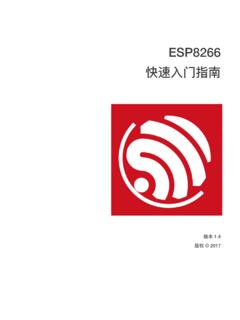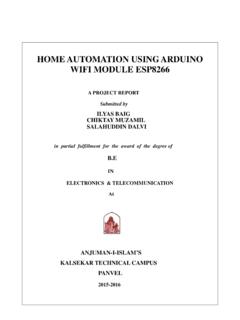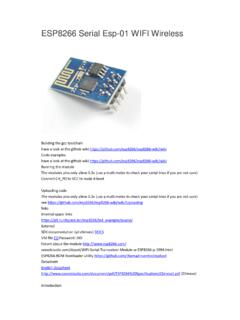Transcription of 0a-esp8266ex datasheet en - Espressif
1 esp8266ex datasheet Version Copyright 2017 About This Guide This document introduces the specifications of esp8266ex . Release Notes Documentation Change Notification Espressif provides email notifications to keep customers updated on changes to technical documentation. Please subscribe here. Certification Download certificates for Espressif products from here. DateVersionRelease Chapter Section and Section Chapter Chapter Appendix II Learning Resources . the power consumption during Deep-sleep from 10 A to 20 A in Table the crystal frequency range from 26 MHz to 52 MHz to 24 MHz to 52 MHz in Section the minimum working voltage from to chip input and output impedance from 50 to 39+j6 . Chapter 3 regarding the range of clock amplitude to ~ VDDPST from ~ to ~ a typo in the description of SDIO_DATA_0 in Table 2-1; Added the testing conditions for the data in Table of Contents 1 .. Protocols 1.
2 3 .. 4 .. Definitions 5 .. Description 7 .. , Memory, and Flash 7 .. 7 .. 7 .. Flash 8 .. and AHB Blocks 8 .. 8 .. Frequency Clock 8 .. Clock Requirements 9 .. 9 .. Frequencies 9 .. GHz Receiver 10 .. GHz Transmitter 10 .. Generator 10 .. 11 .. Management 11 .. Interface 13 .. Purpose Input/Output Interface (GPIO) 13 .. Digital Input/Output Interface (SDIO) 13 .. Peripheral Interface (SPI/HSPI) 14 .. SPI (Master/Slave) 14 .. (Slave) 14 .. Interface 14 .. Interface 15 .. Asynchronous Receiver Transmitter (UART) 15 .. Modulation (PWM) 16 .. Remote Control 16 .. (Analog-to-Digital Converter) 17 .. Light and Button 18 .. Specifications 19 .. Characteristics 19 .. Consumption 19 .. Radio Characteristics 20 .. Information 21 .. - Pin List 22 .. - Learning Resources 23 .. Documents 23 .. Resources $1. Espressif s esp8266ex delivers highly integrated Wi-Fi SoC solution to meet users continuous demands for efficient power usage, compact design and reliable performance in the Internet of Things industry.
3 With the complete and self-contained Wi-Fi networking capabilities, esp8266ex can perform either as a standalone application or as the slave to a host MCU. When esp8266ex hosts the application, it promptly boots up from the flash. The integrated high-speed cache helps to increase the system performance and optimize the system memory. Also, esp8266ex can be applied to any micro-controller design as a Wi-Fi adaptor through SPI / SDIO or I2C / UART interfaces. esp8266ex integrates antenna switches, RF balun, power amplifier, low noise receive amplifier, filters and power management modules. The compact design minimizes the PCB size and requires minimal external circuitries. Besides the Wi-Fi functionalities, esp8266ex also integrates an enhanced version of Tensilica s L106 Diamond series 32-bit processor and on-chip SRAM. It can be interfaced with external sensors and other devices through the GPIOs. Software Development Kit (SDK) provides sample codes for various applications.
4 Espressif Systems Smart Connectivity Platform (ESCP) enables sophisticated features including fast switch between sleep and wakeup mode for energy-efficient purpose, adaptive radio biasing for low-power operation, advance signal processing, spur cancellation and radio co-existence mechanisms for common cellular, Bluetooth, DDR, LVDS, LCD interference mitigation. Protocols b/g/n/e/i support. Wi-Fi Direct (P2P) support. P2P Discovery, P2P GO (Group Owner) mode, GC(Group Client) mode and P2P Power Management. Infrastructure BSS Station mode / P2P mode / SoftAP mode support. Hardware accelerators for CCMP (CBC-MAC, counter mode), TKIP (MIC, RC4), WAPI (SMS4), WEP (RC4), CRC. WPA/WPA2 PSK, and WPS driver. Additional security features such as pre-authentication, and TSN. Open Interface for various upper layer authentication schemes over EAP such as TLS, PEAP, LEAP, SIM, AKA, or customer specific. support ( GHz). Supports MIMO 1 1 and 2 1, STBC, A-MPDU and A-MSDU frame aggregation and s guard interval.
5 Espressif $/$ $1. Overview WMM power low U-APSD. Multiple queue management to fully utilize traffic prioritization defined by standard. UMA compliant and certified. frame encapsulation. Scattered DMA for optimal CPU off load on Zero Copy data transfer operations. Antenna diversity and selection (software managed hardware). Clock/power gating combined with power management dynamically adapted to current connection condition providing minimal power consumption. Adaptive rate fallback algorithm sets the optimum transmission rate and Tx power based on actual SNR and packet loss information. Automatic retransmission and response on MAC to avoid packet discarding on slow host environment. Seamless roaming support. Configurable packet traffic arbitration (PTA) with dedicated slave processor based design provides flexible and exact timing Bluetooth co-existence support for a wide range of Bluetooth Chip vendors. Dual and single antenna Bluetooth co-existence support with optional simultaneous receive (Wi-Fi/Bluetooth) capability.
6 Espressif $/$ $1. Table 1-1. SpecificationsCategoriesItemsParametersW i-FiStandardsFCC/CE/ b/g/n/e/iFrequency (2400M )Tx b: +20 g: +17 n: +14 dBmRx b: -91 dbm (11 Mbps) g: -75 dbm (54 Mbps) n: -72 dbm (MCS7)AntennaPCB Trace, External, IPEX Connector, Ceramic Chip HardwareCPUT ensilica L106 32-bit micro controller Peripheral InterfaceUART/SDIO/SPI/I2C/I2S/IR Remote ControlGPIO/ADC/PWM/LED Light & ButtonOperating ~ CurrentAverage value: 80 mAOperating Temperature Range-40 C ~ 125 CStorage Temperature Range-40 C ~ 125 CPackage SizeQFN32-pin (5 mm x 5 mm)External Interface-SoftwareWi-Fi ModeStation/SoftAP/SoftAP+StationSecurit yWPA/WPA2 EncryptionWEP/TKIP/AESF irmware UpgradeUART Download / OTA (via network) Software DevelopmentSupports Cloud Server Development / Firmware and SDK for fast on-chip programmingNetwork ProtocolsIPv4, TCP/UDP/HTTP/FTPUser ConfigurationAT Instruction Set, Cloud Server, Android/iOS AppEspressif$/$ $1.
7 Home appliances Home automation Smart plugs and lights Mesh network Industrial wireless control Baby monitors IP cameras Sensor networks Wearable electronics Wi-Fi location-aware devices Security ID tags Wi-Fi position system beacons Espressif $/$ $2. Pin Definitions Figure 2-1 shows the pin layout for 32-pin QFN package. ! Figure 2-1. Pin Layout Table 2-1 lists the definitions and functions of each pin. Table 2-1. esp8266ex Pin DefinitionsPinNameTypeFunction1 VDDAPA nalog Power ~ antenna interface Chip output impedance=39+j6 . It is suggested to retain the -type matching network to match the antenna. 3 VDD3P3 PAmplifier Power ~ Power ~ ( )6 TOUTIADC pin. It can be used to test the power-supply voltage of VDD3P3 (Pin3 and Pin4) and the input power voltage of TOUT (Pin 6). However, these two functions cannot be used simultaneously. 7 CHIP_PUIChip Enable High: On, chip works properly Low: Off, small current consumed Espressif $/$ $2.
8 Pin Definitions8 XPD_DCDCI/ODeep-sleep wakeup (need to be connected to EXT_RSTB); GPIO169 MTMSI/OGPIO 14; HSPI_CLK10 MTDII/OGPIO 12; HSPI_MISO11 VDDPSTPD igital/IO Power Supply ( ~ )12 MTCKI/OGPIO 13; HSPI_MOSI; UART0_CTS13 MTDOI/OGPIO 15; HSPI_CS; UART0_RTS14 GPIO2I/OUART Tx during flash programming; GPIO215 GPIO0I/OGPIO0; SPI_CS216 GPIO4I/OGPIO 417 VDDPSTPD igital/IO Power Supply ( ~ )18 SDIO_DATA_2I/OConnect to SD_D2 (Series R: 200 ); SPIHD; HSPIHD; GPIO 919 SDIO_DATA_3I/OConnect to SD_D3 (Series R: 200 ); SPIWP; HSPIWP; GPIO 1020 SDIO_CMDI/OConnect to SD_CMD (Series R: 200 ); SPI_CS0; GPIO 1121 SDIO_CLKI/OConnect to SD_CLK (Series R: 200 ); SPI_CLK; GPIO 622 SDIO_DATA_0I/OConnect to SD_D0 (Series R: 200 ); SPI_MISO; GPIO 723 SDIO_DATA_1I/OConnect to SD_D1 (Series R: 200 ); SPI_MOSI; GPIO 824 GPIO5I/OGPIO 525U0 RXDI/OUART Rx during flash programming; GPIO 326U0 TXDI/OUART Tx during flash progamming; GPIO 1; SPI_CS127 XTAL_OUTI/OConnect to crystal oscillator output, can be used to provide BT clock input28 XTAL_INI/OConnect to crystal oscillator input29 VDDDPA nalog Power ~ Power ~ connection with a 12 k resistor and connect to the ground32 EXT_RSTBIE xternal reset signal (Low voltage level: active)PinNameTypeFunction Note: GPIO2, GPIO0, and MTDO are configurable on PCB as the 3-bit strapping register that determines the booting mode and the SDIO timing $/$ $3.
9 Functional Description Description The functional diagram of esp8266ex is shown as in Figure 3-1. $ Figure 3-1. Functional Block Diagram , Memory, and Flash esp8266ex integrates Tensilica L106 32-bit micro controller (MCU) and ultra-low-power 16-bit RSIC. The CPU clock speed is 80 MHz. It can also reach a maximum value of 160 MHz. Real Time Operation System (RTOS) is enabled. Currently, only 20% of MIPS has been occupied by the Wi-Fi stack, the rest can all be used for user application programming and development. The CPU includes the interfaces as below. Programmable RAM/ROM interfaces (iBus), which can be connected with memory controller, and can also be used to visit flash. Data RAM interface (dBus), which can connected with memory controller. AHB interface which can be used to visit the register. esp8266ex Wi-Fi SoC integrates memory controller and memory units including SRAM and ROM. MCU can access the memory units through iBus, dBus, and AHB interfaces.
10 All memory units can be accessed upon request, while a memory arbiter will decide the running sequence according to the time when these requests are received by the processor. According to our current version of SDK, SRAM space available to users is assigned as below. RF balunSwitchRFreceiveRFtransmitAnalog receiveAnalog transmitPLLVCO1/2 PLLD igital basebandMACI nterfacePMUC rystalBias circuitsSRAMPMUSDIOI2 CPWMADCSPIUARTGPIOI2 SFlashRegistersCPUS equencersAcceleratorEspressif$/$ $3. Functional Description RAM size < 50 kB, that is, when esp8266ex is working under the Station mode and connects to the router, programmable space accessible in heap + data section is around 50 kB. There is no programmable ROM in the SoC, therefore, user program must be stored in an external SPI flash. Flash esp8266ex uses external SPI flash to store user programs, and supports up to 16 MB memory capacity theoretically. The minimum flash memory of esp8266ex is shown in Table 3-1.
















